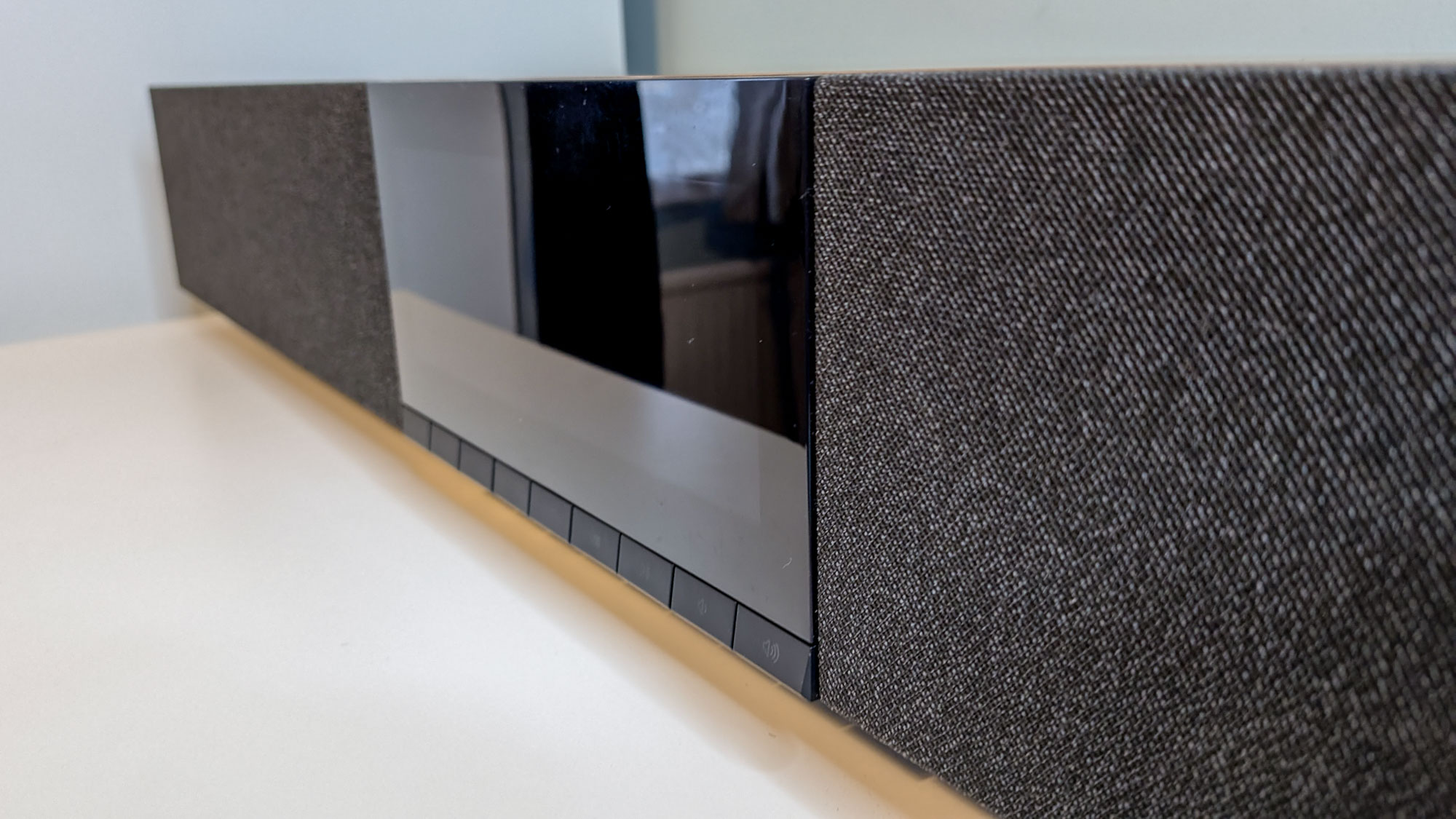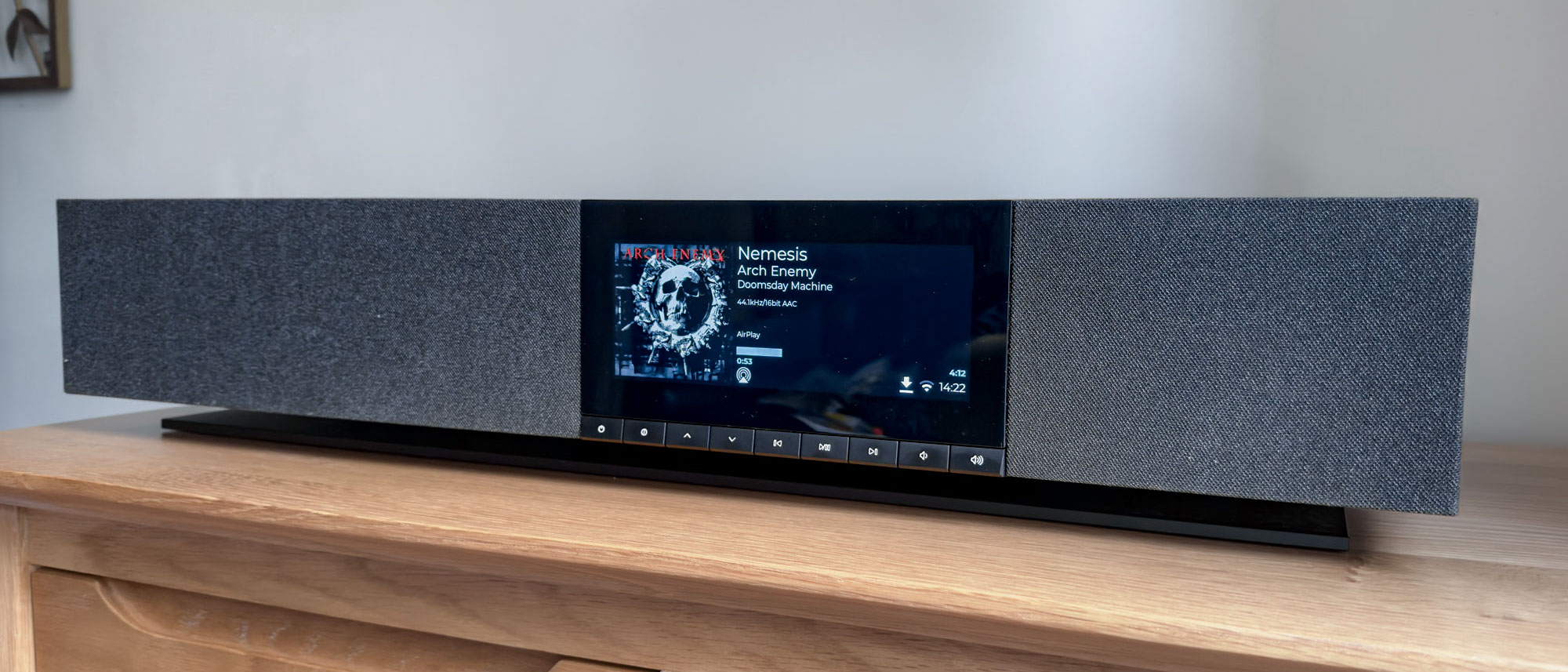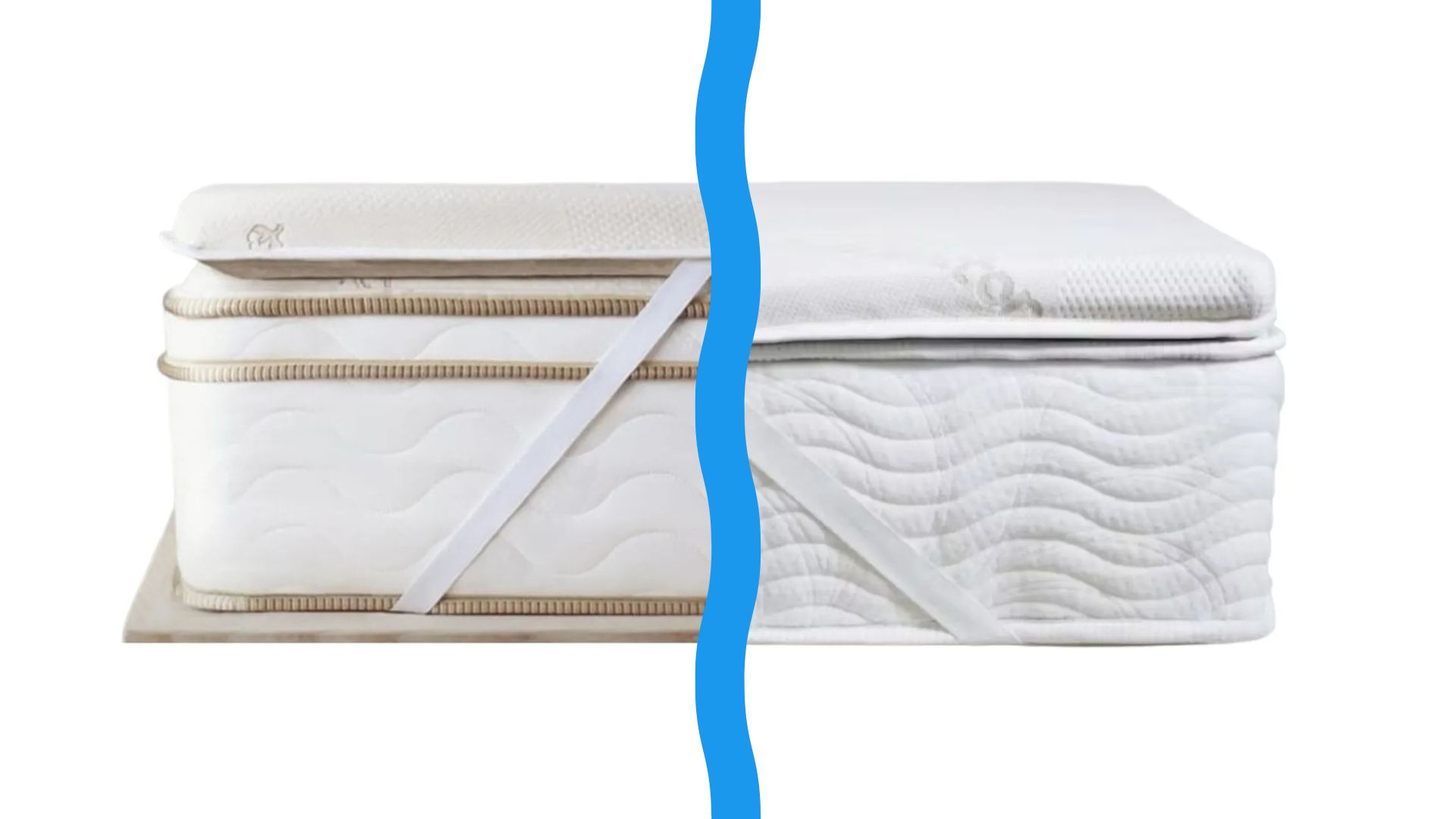Tom's Guide Verdict
The Cambridge Audio Evo One could very easily become the audio center of an entire room. It sounds unlike anything else around, with loads and loads of bass on tap that doesn’t smother the rest of the ensemble. The design is great, and while large, it easily fits into most modern room decor.
Pros
- +
Stunning sound
- +
Deep, impactful bass
- +
Useful screen
- +
Gorgeous design
Cons
- -
Volume controls are hit-and-miss
Why you can trust Tom's Guide
There are no shortage of ways to listen to your music in your living room. You could use one of the best soundbars that sits under your TV, or one of the best Bluetooth speakers you’ve got hidden away in your drawer. One of my favorite devices is part of an ever-improving family — the HiFi replacement all-in-one. I’ve been lucky enough to try out a whole bunch of really high-end ones, although I think I’ve finally fallen on one that beats them all at a not completely unreasonable price.
The Cambridge Audio Evo One is perhaps one of the coolest music-playing devices that I’ve ever used, packed with features and some top-notch sound quality. It also happens to look good while it does it — and even though $1,499 might seem like a high price, when you consider the quality of the package and the price of the competition, you’ll soon find it an audio bargain.
Cambridge Audio Evo One review: Cheat sheet
- What is it? A top-quality all-in-one audio solution
- Who is it for? Those looking for a new speaker that does pretty much everything for their living room.
- What does it cost? $1,499/£1,299/$2,499 AUS
- What we like: The incredible sound quality, the multitude of inputs and the way that it looks.
- What we don’t like: The volume controls can be unpredictable at times.
Cambridge Audio Evo One review: Price and availability
Price $1,499/£1,299/$2,499 AUS
Connectivity Bluetooth, HDMI, RCA, Phono, S/PDIF TOSLink, USB, Ethernet, WiFi
Weight 31.9 ounces
Colors Black
Compatibility iOS, Android, macOS, Windows
Frequency response 38Hz to 20kHz +/-3dB, LF(-10dB) at 32Hz
Considering what you get in the package, the Cambridge Audio Evo One is a very, very good deal. Still, when you say ‘over $1,000’ to your partner, you’re almost always going to get a raised eyebrow no matter how good the device itself may be. Look, if you want a Bluetooth speaker you can hide away in the corner and you’re not too bothered about sound quality or extra features, there are other all-in-one solutions you can try — but they won’t hold a candle to the sonic might and incredible feature set of the Evo One.
For $1,499 you get an incredible sound, room-filling multi-driver speaker that can double as a soundbar, as well as take a Phono connection from a turntable and an RCA connection from other old HiFi separates. Add in the Wi-Fi streaming and Bluetooth connectivity and you’ve got perhaps the most well-rounded all-in-one system that money can buy today.
If you’re looking for something similar but slightly cheaper at the moment then there’s always the also excellent but now aging Naim Mu-so 2nd generation, but that doesn’t feature anywhere near the same amount of ports or features, and it doesn’t quite reach the same bassy depths as the Evo One.
Cambridge Audio Evo One review: Design and build
- Stunning wooden top
- Interesting floating shelf
- Luscious looking dark speaker mesh

I’ve been told off before for calling a piece of tech a sculpture, but the Evo One does feel like an artist was asked to design its wooden and metal enclosure. The top of the device is a piece of wood that looks amazing to the eye, and feels great under your the finger thanks to its untampered textural surface. The mesh that wraps around an almost unbroken circle around the device is soft and inconspicuous from a distance — one could easily believe it was a solid piece, rather than fabric.
Breaking up that circle is a 6.8-inch screen on the front, which houses the device's controls underneath. The display, while not the highest resolution in the world, is easily legible from across the room, and gives you a number of fun readouts. My favorites are the bouncing VU meters, like those found on old Hi-Fi gear that I find myself glancing at jealously when I browse eBay. There’s more to the screen than just that of course, which I’ll get to later, but I will say this now — it doesn’t stick out, and it doesn’t ruin the aesthetic of the device.
Get instant access to breaking news, the hottest reviews, great deals and helpful tips.
The Evo One does feel like an artist was asked to design its wooden and metal enclosure.
The whole thing is sat on a metal stand which makes it look like a portion of the device is floating above the cabinet it's sitting on. It’s deceptive, though, given that the device is mostly supported by a big chunk that hangs below the screen. In person, the whole package looks amazing, and will easily fit into any room in which you might want to place it.
It helps of course that it's all built with incredible precision and with great attention to detail and quality. The wood is real wood, and the metal parts are cold to the touch and perfectly smooth. The screen has a glass cover, and when turned off, you’d not know there was a screen there. The speaker mesh is tight and blemishless, and there's a little logo on the top is inlaid perfectly into the wood around it. And it all weighs enough to sink a small boat — this system is designed for a very solid cabinet or sideboard this one.
Cambridge Audio Evo One review: Controls
- Useful physical controls
- Helpful app
- Hit and miss volume control

There are a couple of ways to control the Evo One. The first is the row of controls under the screen, which feel like they’ve been pulled from a high-end 90's stereo. They’re finished in satin black plastic, but feel great when clicked with plenty of positive feedback. They illuminate to tell you what they do during use as well, which is nice if you’re into listening to music in the dark.
There are 9 buttons, and they go from left to right: Power, info, up, down, skip back, play/pause, skip forwards, volume up, and volume down. For the most part, the buttons work perfectly without hitches, but here comes my only real critique of the device. The volume buttons, depending on the source, can sometimes jump around the levels erratically when trying to dial in the level. It’s no great issue, and there are other more precise ways to manipulate the volume, but it's worth bearing in mind.
You can also control the device with your phone, and this is mostly the way I’d do it. Hop into Cambridge Audio’s ‘Stream Magic’ app, and you’ll find all the options for input source, volume, and even all the EQ settings and screen controls. It’s a very fully featured app that can even control your streaming services in one place. There’s also AirPlay 2, Chromecast, and other streaming-specific connections so you can stream directly from your favorite apps. The app is extremely flexible, and more importantly, easy to use.
Cambridge Audio Evo One review: Connectivity
- Loads of ports
- Great WiFi connectivity
- Bluetooth on board to boot
There are loads of ways to connect stuff and play music with the Evo One. First off, are all the plugs and ports hidden around the back — one of which is super exciting. While the RCA connector is a great option for plugging in a CD player, there’s a phono input right next to it so that you can hook up a turntable. That’s a grounded connection as well, so you can connect a player that doesn’t have a built-in pre-amp thanks to the hardware inside the Evo One. It works great too, with some lovely warmth and engagement when you spin your vinyl on the device.

There’s a physical internet port thanks to the Ethernet jack as well, for a more solid connection. Not that I ever needed to worry — the Wi-Fi on board was about as faultless and steady as they come. The ethernet port is flanked by two more interesting connections. There’s a TOSLink connector for optical, so you can hook it up to old TVs and other digital devices, and then an HDMI port so you can use the box as a defacto soundbar. That latter option is eARC compatible as well, so your TV remote will change the volume when you’re using it as such. This is a tall device so if you’re going to use it as a soundbar you’ll want your TV wall mounted slightly higher, but given the audio on board you won’t be disappointed when you do. There’s no Dolby Atmos on board unfortunately though, and you’ll be ‘stuck’ with stereo sound rather than surround sound.


The final port on the back is a USB port, and it allows you to hook up a HDD filled with music so that you can listen to your collection without the need for a constant internet connection. It’s an incredibly well-rounded selection of ports, and the inputs are all labeled upside down so you can read them when you’re looking over the top of the device. Smart.
There’s Bluetooth as well, and it works perfectly. Connect your phone or other device and listen wirelessly.
Cambridge Audio Evo One review: Sound Quality
- Spectacular bass response
- Clear, concise highs
- Well-rounded, musical mids
As you might expect from something that has 12 drivers and 700 watts of amplification on tap, the Evo One sounds massive. It’s got some of the best bass response I’ve experienced in an all-in-one system, thanks to the 6 long-throw woofers that Cambridge Audio has packed in. It really has to be listened to to be believed — the Evo One is not a small device, but it still somehow manages to sound even bigger than it actually is. It has no problem filling a listening room or a living room, and packs in some incredible room-shaking audio.

That’s not to say the highs and mids have been forgotten, far from it. The highs are crystal clear and sparkle over the rest of the sonic ensemble. The mids are well-rounded, and give body to already tight and controlled sound. It’s a great experience, one that’s only compounded by what I can only describe as audio black magic. While it’s one box rather than a pair of separate stereo speakers and it doesn’t use any Spatial Audio wizardry to make the music sound more 3D, the Evo One does a spectacular job of making the music sound like it’s coming from different sources around the room. There’s great stereo separation, and if you close your eyes, you will struggle to tell where the Evo One is if you don’t know already.
Nile’s Chapter for Not Being Hung Upside Down on a Stake in the Underworld is blistering death metal with some impressive low end, and often finds itself boomy on bassier hardware. Not so with the Evo One — while you get every single bass hit reverberating around your chest, the distorted guitars are clear and crunchy, the drums impactful, and the snarled vocals brutal and terrifying. It’s a tour de force of the heaviest kind, and as a result, it’s loads and loads of fun.

Going back a few decades and The Carpenter's wonderful Bizarre cover of Calling Occupants of Interstellar Craft takes you on a journey through the stars. Karen Carpenter's stunning voice carries across the room, piercing through the massive orchestral weight of the composition. The bass is there to give more dimension to the drum line and bass guitars, while the smooth synths show off more of the strong mid-range frequency response. One couldn’t call it an analytical performance, and it’s great not just for background music but more dedicated, purposeful listening as well.
Pat Metheny’s Last Train Home is an instrumental jazz stunner, with plenty of depth and detail for the Evo One to get its teeth into. The chuffing train-like drum beat is crisp and clear, and the bass adds more depth to the plucked string line. The double bass is not just strong, but controlled and tight. It’s all layered with the synth line for a massively rewarding listen — and then topped off with the piano at the forefront.
Cambridge Audio Evo One review: Verdict

If you’ve got $1,500 to spend and you want something that can become the audio center of the home, then you’d do very, very well with the Evo One. Cambridge Audio might just have made the greatest all-in-one streamer ever, and when you consider the build, the sound and the features, the price doesn’t seem like a tall ask. In fact, when you consider the prices of the competition from the likes of Bowers & Wilkins and Devialet, it almost feels like a bargain.
When a device only has one tiny complaint that you can mostly ignore, you know you’re in for a treat, and the Evo One is just that. Now, as I pack it away into its box to send it back to Cambridge Audio, I’m already trying to work out how I can justify the $1,500 price point — and honestly, my list is ever-growing and more persuasive to the little accountant in me that looks after my money. I need one like I need breath.
More from Tom's Guide
- 5 best Prime Video miniseries to binge-watch this weekend
- Samsung XR headset suggests the end of 'Hey Google' is imminent — here's why
- Anthropologie knocks 50% off furniture and decor — 9 deals I'm shopping ahead of the holidays

Tammy and her generous collection of headphones have found a new home — Tom's Guide! After a two-and-a-half-year stint as iMore's resident audiophile, Tammy's reviews and buying guide expertise have more focus than ever on Tom's Guide, helping buyers find the audio gear that works best for them. Tammy has worked with some of the most desirable audio brands on the planet in her time writing about headphones, speakers, and more, bringing a consumer focussed approach to critique and buying advice. Away from her desk, you'll probably find her in the countryside writing (extremely bad) poetry, or putting her screenwriting Masters to good use creating screenplays that'll never see the light of day.

